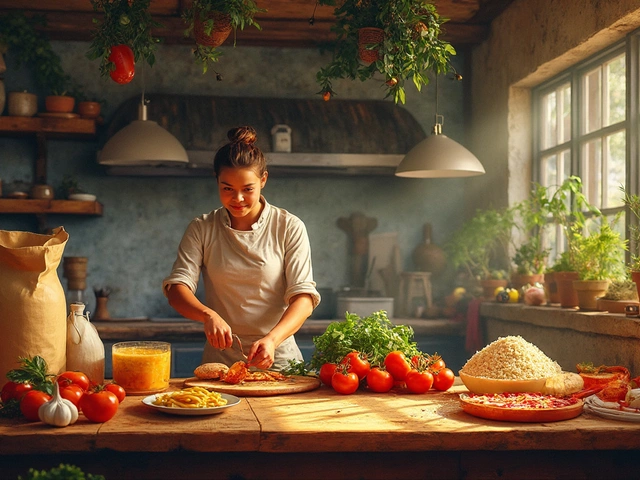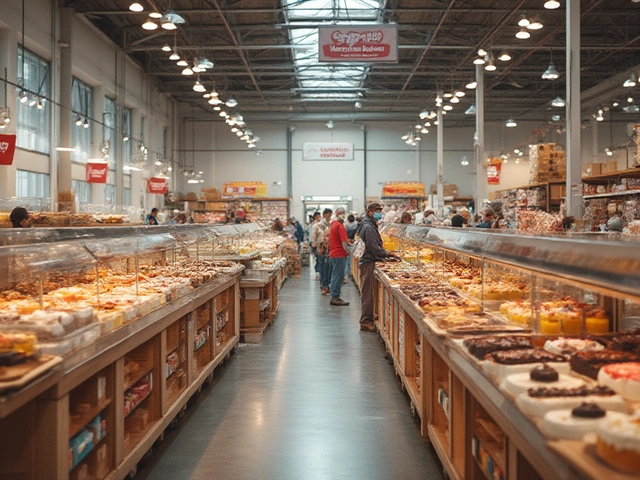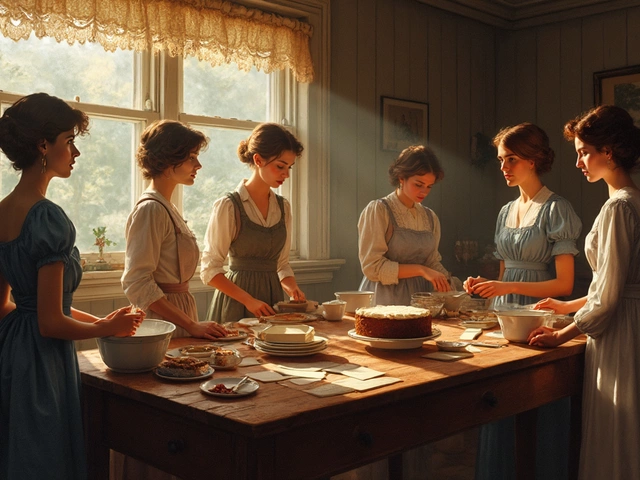
Ever heard of a cake so famous, it's called the queen of cakes? Spoiler: there really is such a thing, and it’s not just some random label. If you’ve ever wandered into a British bakery, you probably stumbled onto it without realizing its royal rep. The Victoria sponge is the one that wears this title best, and there’s a good reason why bakers keep coming back to it.
But why does this particular cake get so much love? It’s all in the balance of fluffy sponge, just-right sweetness, and those two classic layers filled with fruit jam and cream. The queen herself—yep, Queen Victoria—used to enjoy a slice with her tea, pushing it right into legend territory. Now, knowing what makes a cake stand out could help you pick your next recipe or even level up your baking game. Ready for the inside scoop?
- Chasing the Queen: What Does the Title Mean?
- Victoria Sponge: The Cake That Wears the Crown
- Breaking Down the Recipe: Secrets Behind Its Texture
- Other Cakes That Tried for the Throne
- Quick Tips to Perfect Your Own 'Queen' Cake
Chasing the Queen: What Does the Title Mean?
So where does this whole “queen of cakes” thing come from? It isn’t some catchy name whipped up by food bloggers. In baking circles, the title points straight to the Victoria sponge—named after Queen Victoria herself. This cake became her go-to snack with afternoon tea, and soon, people started calling it the queen of cakes in her honor. Sounds like a legend, but it’s rooted in real history.
Here’s a quick fact: the Victoria sponge first started popping up in English cookbooks in the mid-1800s, right when Queen Victoria set the trend. She’d eat it between sips of tea, making it the ultimate cake for social gatherings. If you’re curious about how big this cake is in the world of baking, check this out:
| Year | Victoria Sponge Mentions in UK Cookbooks |
|---|---|
| 1855 | 2 |
| 1900 | 27 |
| 2020 | Hundreds |
The name stuck, not just because of the queen, but because bakers started judging their cake skills by how well they could pull off this recipe. It’s simple on the surface, but there’s nowhere to hide—no frosting overload or flavor cover-ups. The real test is in texture and taste.
"The Victoria sponge might seem plain, but it’s the most honest cake. If you can master it, you can bake almost anything." – Mary Berry, British baking legend
People even use the Victoria sponge as the gold standard in Britain’s top baking competitions. So when you hear “queen of cakes,” it actually means the cake that everyone measures their skills against. This isn’t just tradition—it’s a real mark of being top notch at baking.
Victoria Sponge: The Cake That Wears the Crown
This is the cake that pretty much started it all in the world of classic British baking. The Victoria sponge isn’t just tasty—it’s got history. Queen Victoria herself made this cake famous. She was known to have a slice with her afternoon tea almost daily. People soon started calling it the "queen of cakes" because no other dessert had that royal stamp and such a simple, “anyone-can-make-it” vibe.
This cake is made with basic ingredients—eggs, sugar, butter, and self-raising flour. What sets it apart is the ratio. Bakers swear by equal parts of each, which gives that signature lightness. The filling? A layer of fruity jam (usually raspberry or strawberry) plus whipped cream. No crazy flavors here, just straight-up comfort and balance.
| Ingredient | Traditional Amount |
|---|---|
| Self-raising flour | 200g |
| Butter | 200g |
| Sugar | 200g |
| Eggs | 4 medium |
| Raspberry or Strawberry Jam | 4 tbsp |
| Whipped Cream | 100ml |
No icing on top, just a dust of powdered sugar. That naked top is a sign you’ve stuck to the roots. In fact, at the Women’s Institute baking competitions—the strictest amateur contests in Britain—the queen of cakes always means Victoria sponge, and judges check for perfect rise and a crumb that melts in your mouth.
Quick heads-up from British baking circles: “Victoria Sandwich” and “Victoria sponge” are the same thing. So don’t get confused if you see both names. It’s one legendary cake, and honestly, it’s a great place to start if you want to impress someone with homemade baking and zero drama. Just nail the ratios, and you’ll see why it’s stayed the favorite for over a hundred years.

Breaking Down the Recipe: Secrets Behind Its Texture
The texture of the Victoria sponge—aka the queen of cakes—is what sets it apart. It’s light, airy, and tender, but not crumbly or dry. That perfect crumb is no accident. It all comes down to mixing technique and ingredient balance.
Here’s what actually matters:
- Room-Temperature Ingredients: If the butter and eggs are too cold, nothing mixes right. You’ll get lumps and the batter won’t trap air, which is critical for rise. Take your ingredients out of the fridge at least an hour before you bake.
- Creaming Method: This cake uses the classic method: beat the butter and sugar until pale and fluffy. That’s where you add loads of air, so don’t rush it. Most bakers recommend beating for at least 2-3 minutes with an electric mixer.
- Self-Raising Flour: In the UK, most recipes use self-raising flour instead of all-purpose and baking powder. It gives a consistent rise and softer crumb. If you don’t have it, add 2 teaspoons of baking powder per cup of all-purpose flour as a swap.
- Gentle Folding: Once you add flour, use a spatula and fold slowly. You want to keep all the air you just whipped in, so no rough mixing. Over-mixing is a big reason cakes turn out dense.
- Bake Evenly: Divide your batter into two pans so the cakes cook through without getting tough edges. The usual bake is 25 minutes at around 350°F (180°C).
That famous filling—typically strawberry or raspberry jam and whipped cream—keeps the cake soft but not soggy. Always layer once the sponge has cooled, or the cream melts and ruins the texture.
Not all sponges are created equal, so if one layer looks too pale or heavy, it’s usually a sign that the oven temp was off or there was too much flour. Stick to equal weights of butter, sugar, eggs, and flour, and you’ll get that classic Victoria sponge feel every single time.
Other Cakes That Tried for the Throne
The battle for the title of queen of cakes has some serious competition. Plenty of cakes have their own fans and unique stories, so it’s worth knowing which ones almost claimed the crown.
The Genoise, for example, is big in Italian and French baking. It’s similar to a sponge cake, relies heavily on beating eggs for lift, and pops up in fancy layered desserts. Genoise fans love it because you can shape and fill it a hundred different ways, but it never quite reached British table stardom like the Victoria sponge did.
Then there’s Angel Food Cake—so light, it literally uses only egg whites and skips the fat. Americans have been baking it since the 1800s. It’s a crowd-pleaser if you’re after something airy, but it just doesn’t have the rich touch or the history with royalty that helped boost the Victoria sponge.
The Black Forest cake (Schwarzwälder Kirschtorte) goes all out, layering chocolate cake, whipped cream, and cherries. It’s a must-have in Germany and super impressive, but a true queen has to be loved by all, not just for special occasions or holidays.
Don’t forget about Red Velvet. It’s modern, striking with that deep red color and tangy cream cheese frosting, but it really only popped into the cake spotlight in American bakeries during the 20th century. Plus, loads of folks debate what makes a "real" Red Velvet anyway.
- Genoise: Sponge cake with continental charm, but less popular outside fancy patisseries.
- Angel Food Cake: Super light, all egg whites, a classic in the U.S., but sometimes too plain for global appeal.
- Black Forest: Rich, chocolatey, heavy on cherries and cream, iconic in Europe.
- Red Velvet: Bold colors, moist texture, but more recent on the scene and has its haters.
So while a bunch of cakes bring something different and delicious to the dessert table, none have quite managed to steal the universal love—and tradition—that keeps the Victoria sponge on top.

Quick Tips to Perfect Your Own 'Queen' Cake
Nailing a Victoria sponge, aka the queen of cakes, is more about simple moves than magic. Let’s break it down so your next bake leaves everyone talking (in a good way).
- Room temperature ingredients: Start with eggs and butter left out of the fridge for a bit. Cold butter just doesn’t cream right. Soft butter, light cake.
- Weigh everything: Guesswork is how dry cakes happen. Cup measurements can change from batch to batch, but a kitchen scale makes sure you get it right every time.
- Beat, don’t over-beat: Cream your butter and sugar until it’s pale and fluffy—about 3-5 minutes. Once flour goes in, give it just enough of a mix or you risk that rubbery texture.
- No baking powder overload: More baking powder doesn’t mean more rise. Stick to the recipe—1 teaspoon per 100g of flour is plenty or the cake can taste “off.”
- Go for good jam: Sorry, cheap strawberry jam won’t cut it. Use a thick, good-quality strawberry or raspberry jam and real whipped cream for that classic feel.
- Bake right away: Victoria sponge batter hates waiting around. Once your mix is done, get it into the oven ASAP for the best lift.
| Tip | Why It Matters |
|---|---|
| Room Temp Ingredients | Even mixing, fewer lumps, softer sponge |
| Accurate Weighing | Consistency, perfect batter each time |
| Right Mixing Technique | Light, fluffy texture—not dense |
| Quality Jam & Cream | Fresh, rich flavor, avoids sogginess |
One last pro tip—don’t even think about drenching your cake in syrup or heavy icing. The whole point of the queen of cakes is to keep it simple and let the flavor do the talking. If in doubt, dust lightly with sugar before serving, and keep leftovers covered to lock in that freshness.





